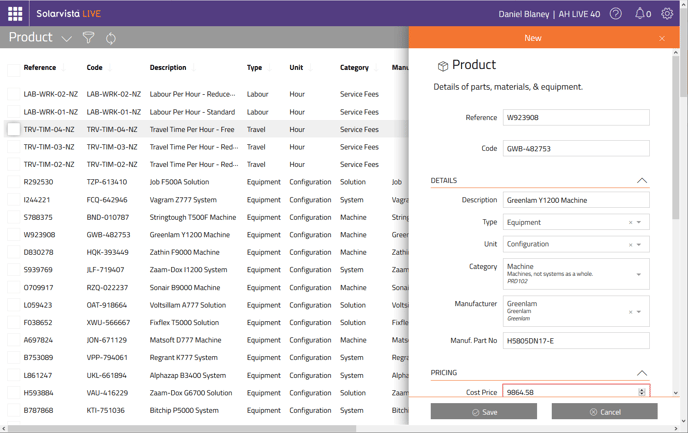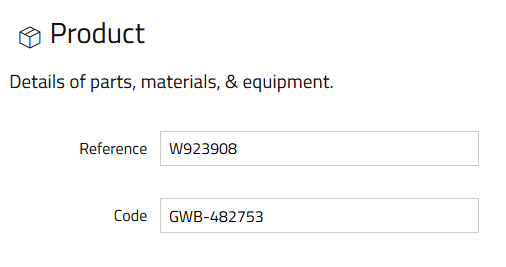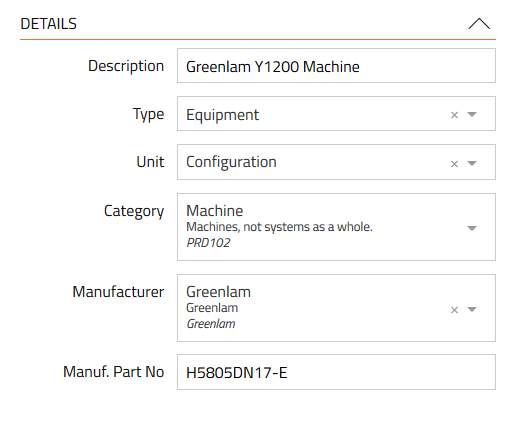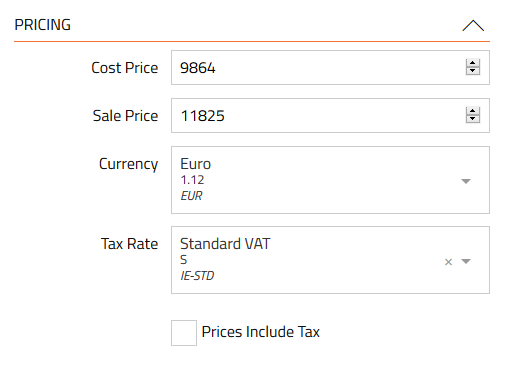Products
A detailed look at the fields and dependencies in the Product records, how to create a new Product record & editing existing Products.
![]()
The “Product” record holds information about the parts, materials, equipment or “named/fixed” services you provide. It also holds pricing information which is used to calculate the billing ![]() from chargeable Jobs/Work Items.
from chargeable Jobs/Work Items.
Some features are dependent opon your select plan for your account.
Indicates a feature is only available in Standard or above.
Indicates a feature is only available in Enterprise.

The record is referenced by two parts of the solution; Equipment/Assets and Parts/Billing. If you manage parts/materials or have equipment or assets in your organisation, they should be setup. It is possible to use Solarvista for non-product/parts/equipment scenarios and many of the work items types/job types can have their reference removed.
The Type field is important to set correctly as it affects where the product records appear. For example, the pricing for labour rates is stored as a ‘Product’ but to use these, they must be assigned a Type of “Labour”.
The Tax Rate can be set if this should override the default tax rate of the Customer.
Where Product Records are Used
The following files refer to Supplier records so if you plan to use any of these, setting up the records in this file will be important or even critical:
Data Sources:
- Equipment
- Service Levels

- Pricing Policies

- Price Book

- Actions
Activity/Forms
- Part Used
- Part Required
- Part Logistic
Pre-requisite Files for Products
When setting up Product records, it is recommended to review the other data files that may need to be referred to by each record. These are the files that you may need to setup in advance:
- Currencies
- Tax Rates
- Categories (Products)
- Manufacturers
- Suppliers
Product Categories are a requirement if you plan to use Pricing Policies to calculate adjusted pricing for invoices etc. Manufacturers are only required if differentiation by manufacturers is made in skills and/or pricing.
Field Descriptions for Products
The ID section holds the unique ID and Code (e.g. a “part number”) for the product:

Reference - holds the unique ID for the record (most records in Solarvista have one of these). It cannot contain any spaces or non-standard characters. Once the record is saved, it is not possible to edit it afterwards. In most default situations, the Reference is automatically set using a counter sequence, however, you can setup your own if you prefer.
Code – the “product code”, “part number” or whatever is used as a day to day unique code for the product. Normally, this would equate to the codes used within your business.
The Details section holds the detail about the product:

Description – a single line description of the product. This should be a compact description that is unique and in a searchable format.
Type – this defines the type of product so that they can be presented in different parts. The options are:
- Parts/Materials – the product is related to a physical part or material.
- Task – the product is a defined task that you provide as a single combined fee.
- Service – the product is a service charge for defined service e.g. a ‘call-out’ fee.
- Labour – the product is a rate for "working" labour charges.
- Travel – the product is a rate for "travel" labour charges.
- Equipment – the product is a serviceable, piece of equipment that can be added to agreements or have a job created for it.
- Task - the product is a defined action.
Unit – the unit applicable e.g. “each”, “pack 10” etc.
Category – this categorises the product into a group. The definitions of these held within the Categories file with the “Type” field = “Product”. This field has a significant use within Solarvista to differentiate pricing calculations and/or skillsets. For example, "Screws", "Machines", "Pipes", etc.
Manufacturer – allows a product to be classified with a Manufacturer. These are used within Skills definitions and Pricing Policies, if required.
Manuf. Part No – if a different part number exists for the product as defined by its manufacturer, it can be stored in this field.
The Pricing section holds details about the product costs and selling prices.
These are used in the billing process ![]() , however these fields are still available in Lite
, however these fields are still available in Lite ![]() for reference only:
for reference only:

Sale Price – the standard selling price to be used when computing invoices. This price is used as a basis for discounts applied with Pricing Policies.
Cost Price – the expected cost price to be used when analysing costs. Also used with Pricing Policies if calculating charges from costs as a markup.
Currency – sets the currency that the above prices are denoted in. This field is itself defaulted from the setting in Account Settings. Currencies are pre-populated in Solarvista for most countries’ currencies, but these should be edited to ensure the rates and codes are correct before use.
Price Includes Tax – if checked, denotes that the prices above include tax at the rate set in the field below.
Tax Rate – determines the tax rate that is default for the product. This is especially relevant if the Prices Include Tax box is checked.
The Supplier section holds information about the normal supplier of the product:

Supplier – the normal Supplier of the product.
Supplier Ref – the specific reference or part code used by the Supplier (if different to Code or Manuf. Part No.).
The Other section holds miscellaneous additional information:

Memo – a free text field that can be used for any purpose.
Status – defines the status of the Product as follows:
- Draft – the product record is being setup and is not available for selection yet.
- Active – the product record is active and is available for selection within Solarvista.
- Obsolete/Superseded – the product is no longer used, it should not appear in selection lists but is kept for long term integrity of data.
- Cancelled - the product is no longer required and can be purged/deleted when applicable.
Creating a New Product Record
To create a new Product record:
- Click on the “Plus” button.

A menu will appear. - Within the “Data Sources” section, find “Product”.

- Click on “Product”.
- A new “empty” Product record will appear.
- Populate all fields as you require.
- Click on the “Create” button.

- You may need to refresh the page to see the new record in a view.

Editing a Product Record
To edit a Product record:
- From the main menu, select Products.

The default view for Product will open. - Click on the Quick Filter button.

- Enter criteria for the Supplier record you are looking for and click Apply button.

- The view will update. Find the record you are wanting to edit.
- Click anywhere on the row that shows the record. The record will open.
- You can edit any field that allows editing (some could be set to read only).
- Click on “Save” button to save changes.

Deleting a Product Record
To delete a Product record.
- From the main menu, select Product. The default view for Products will open.
- Click on the Quick Filter button.

- Enter criteria for the Product record you are looking for and click Apply button.

- The view will update. Find the record you are wanting to delete.
- On the left side of the view is a column containing checkboxes.
- Check the box of the record you want to delete.
- Click the “Delete” button on the top right.

A slide in dialog will appear prompting you to confirm the delete, by typing in the word “DELETE” again. - To confirm, click the “Delete” button and the record (or records will be deleted).

Note: You cannot delete a Product record that is already in use with a Work Item i.e. Jobs. You can delete Product records referred to only by other Data Sources however this will leave those records without an associated to a valid Product record. If this happens by accident, you can manually recreate the record ensuring the Reference is identical. You can also change the status of the record to prevent it appearing on screen in future whilst maintaining historical integrity.
Customising or Adding New Fields
Solarvista™ is built upon a uniquely flexible platform that allows you to edit fields (or remove them in some cases) as well as add your own fields. These new fields (or edited characteristics of existing fields) automatically become available within the web portal and the mobile apps. For more information, refer to the Customising section.
Importing Product Data in Bulk using Import Tool
If you have a lot of Product information to enter, you may prefer to upload this using the Import Tool that’s built into Solarvista. The Import Tool enables Product records to be created from “CSV” text files. CSV files can be created from a wide range of popular applications including Microsoft Excel. For more information on importing data into Solarvista, please refer to the article here.